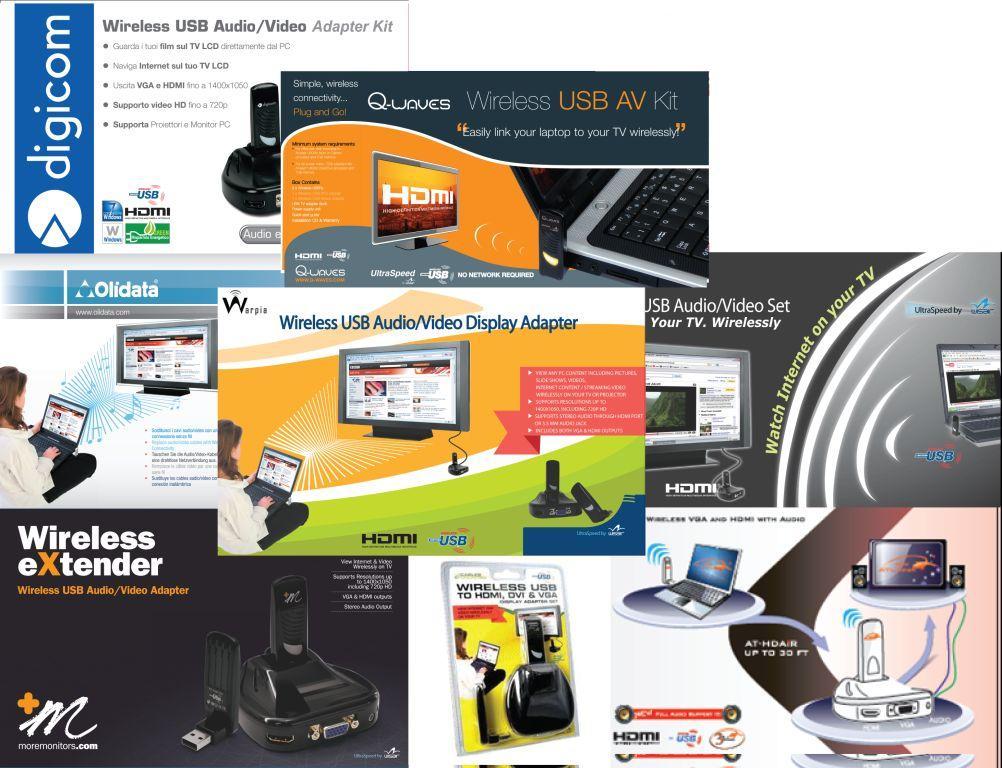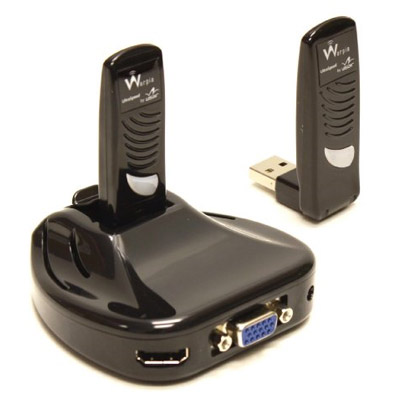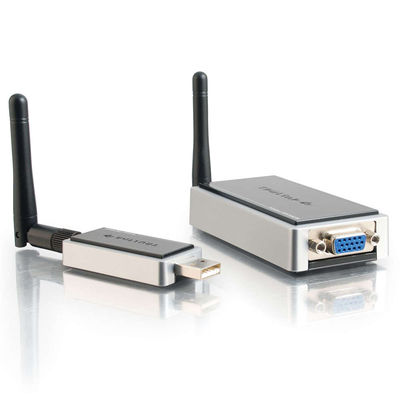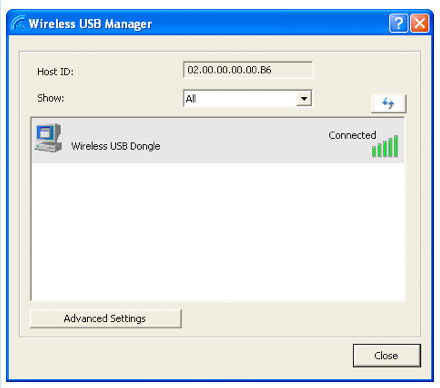Wireless video: external wireless video cards
So, let's talk about the first ones in the class of wireless video transmission devices - these are external wireless video cards. Such devices are detected by your computer / (laptop, no) by a book as an additional module for connecting a monitor or TV. So, a second video card appears in your system, which you can configure with standard, system tools.
Attention, under the cut a lot of pictures!
Of course, the most important thing that interests us is how it all looks and what characteristics it has. Naturally, the video signal is transmitted wirelessly, but where and where? Let's get it right.
So that in our system there is some additional. device, to the computer, you still need to connect something. Almost never occurs an imitation of an additional video card at the software level. Thus, all such devices consist of two parts: directly the wireless video card itself, to which you need to connect a monitor, and some USB adapter that supports high-speed wireless connection directly to the video card. In other words, the existing USB-video card is taken as the basis, only here the USB-connection to the computer is replaced by the connection according to the Wireless USB (WUSB) standard. Such kits look like this:
1. Kits built on the basis of chips from the Israeli company Wisair ( wisair.com/shop ):

Black ones with VGA and HDMI:

Same, only white and with, 3.5mm-jack:

Same, with only one DVI port and wireless USB hub:

2. IOGear kit ( www.iogear.com/product/GUW2015VKIT )

3. Solution-based products Alereon ( www.alereon.com/products/reference-designs ):

4.Ustroystvo of-the To-Cables' the Go ( www.cablestogo.com/categories.asp?cat_id=3800 ):

As you can see, all devices are similar by the presence of a USB transmitter and receiver with a built-in video (and in most cases an audio) card. A reasonable question arises: but why do we need some new Wireless USB, if there is, for example, such a familiar, beloved and run-in Wi-Fi? Why is it worse? Moreover, now you won’t surprise anyone with the Wi-Fi module built into your computer / laptop ...
... The answer lies in the radio transmission standards. Our devices use Wireless USB, which, in turn, is based on the UWB standard - Ultra-Wide band, or ultra-wideband. Unlike Wi-Fi operating at a fixed radio frequency (in most cases, at 2.4Ghz or 5Ghz), UWB simultaneously uses a whole spectrum of frequencies - from 3.1Ghz to 10.6Ghz, this allows you to transfer a lot of information with minimal energy consumption.
However, there are no ideal standards, and UWB also has its drawbacks - ultra-wideband transmission, although productive, is very sensitive to distance - the more transmission bands used at the same time, the more interference there is: problems arise at the line of sight of more than 10 meters from devices with a connection. With obstacles, devices get along even worse: they just don’t work through walls and that’s it.
For comparison: UWB is as if you were pulling some kind of fabric from one place to another in a strong wind. It is difficult ... In turn, Wi-Fi is pulling the same fabric, but with one or two or three (MIMO) threads is much slower, but the wind at long distances is not an obstacle.
Design, construction
From a hardware point of view, we can say the following: all devices are compact enough, but do not forget that video cards cannot be powered by the Holy Spirit, therefore, next to the monitor / projector to which the image is being transmitted, it is necessary to provide an additional outlet for the receiver power adapter.
But the transmitter is powered by voltage from the USB port of a computer / laptop. It is worth noting that during operation the transmitter heats up quite a lot, this is due to the intense, broadband transmission of the radio signal.
Ultimately, depending on the direct characteristics of the device you are using, you can get an additional, wireless VGA interface, wireless DVI or wireless HDMI for your computer.
Almost all of the above devices have activity indicators - LEDs that signal the intensity of signal transmission.
Software
The device software consists of two components: the Wireless USB Manager, which controls only the communication between the receiver and the transmitter (by the way, when connecting for the first time, in addition to updating the firmware of the devices, it is necessary to pair (pair) the receiver and the transmitter, which is very similar to bluetooth ): the

second component of the device software is the DisplayLink program installed in the tray, from the company of the same name

This program was originally designed to control USB-video cards, but since in our case it imitates just such a connection, it works well on top of the Wireless USB Manager.
After the first connection, the installation of drivers and programs, and the procedures for updating the firmware (firmware) and pairing of devices, you just need to connect the transmitter to the computer, and the video signal will immediately begin to be transmitted to the receiver. Removing the device is as easy as connecting.
Several standard settings for the remote monitor are available to you: copy mode of your screen or expanding your desktop in any direction: a wirelessly connected monitor or TV will complement the main one on the right, left, top or bottom.

Programs and drivers work both under Windows XP, Vista, 7, and under Mac OS X.
For devices, the minimum system requirements are quite high: you need a computer with an Intel Atom processor or similar, with a frequency of at least 1.6Ghz and at least 512Mb of RAM for Windows XP and at least 1Gb for the rest of the OS. This is due to the fact that most of the calculations related to displaying images on a wireless screen are not performed at the hardware level, but rather with the driver in conjunction with DisplayLink, which, in turn, decently loads the central processor.
conclusions
This class of devices is intended mainly for lectures and presentations. The device’s performance is enough to display presentations, slide shows and average quality videos, such as youtube, without delay. The presenter, usually in the same room as the projector or screen with his presentation, will benefit from mobility, will be able to move around the room with his own laptop and place it at different lectures in different places, depending on the current need.
For home, devices can also do a good job: while you are working on a laptop or computer, your Family members can watch video from it on an HD TV up to 720progressive. Without wires.
The devices also bring some mobility during and after the repair: you don’t need to ditch the walls to lay a bundle of wires and bring it to a fixed place - now you just need to connect a small receiver box to the TV / plasma or projector, and insert a small transmitter and signal immediately into the computer will go.
In RuNet, I found only two places where you can find such devices, and it’s not cheap:
bezprovodnik.ru and
bezprovodnoe.ru
If profitability plays a role for you and you are ready to wait a month, I recommend ordering such toys with eBay or Amazon.
To be continued…
Attention, under the cut a lot of pictures!
Of course, the most important thing that interests us is how it all looks and what characteristics it has. Naturally, the video signal is transmitted wirelessly, but where and where? Let's get it right.
So that in our system there is some additional. device, to the computer, you still need to connect something. Almost never occurs an imitation of an additional video card at the software level. Thus, all such devices consist of two parts: directly the wireless video card itself, to which you need to connect a monitor, and some USB adapter that supports high-speed wireless connection directly to the video card. In other words, the existing USB-video card is taken as the basis, only here the USB-connection to the computer is replaced by the connection according to the Wireless USB (WUSB) standard. Such kits look like this:
1. Kits built on the basis of chips from the Israeli company Wisair ( wisair.com/shop ):

Black ones with VGA and HDMI:

Same, only white and with, 3.5mm-jack:

Same, with only one DVI port and wireless USB hub:

2. IOGear kit ( www.iogear.com/product/GUW2015VKIT )

3. Solution-based products Alereon ( www.alereon.com/products/reference-designs ):

4.Ustroystvo of-the To-Cables' the Go ( www.cablestogo.com/categories.asp?cat_id=3800 ):

As you can see, all devices are similar by the presence of a USB transmitter and receiver with a built-in video (and in most cases an audio) card. A reasonable question arises: but why do we need some new Wireless USB, if there is, for example, such a familiar, beloved and run-in Wi-Fi? Why is it worse? Moreover, now you won’t surprise anyone with the Wi-Fi module built into your computer / laptop ...
... The answer lies in the radio transmission standards. Our devices use Wireless USB, which, in turn, is based on the UWB standard - Ultra-Wide band, or ultra-wideband. Unlike Wi-Fi operating at a fixed radio frequency (in most cases, at 2.4Ghz or 5Ghz), UWB simultaneously uses a whole spectrum of frequencies - from 3.1Ghz to 10.6Ghz, this allows you to transfer a lot of information with minimal energy consumption.
However, there are no ideal standards, and UWB also has its drawbacks - ultra-wideband transmission, although productive, is very sensitive to distance - the more transmission bands used at the same time, the more interference there is: problems arise at the line of sight of more than 10 meters from devices with a connection. With obstacles, devices get along even worse: they just don’t work through walls and that’s it.
For comparison: UWB is as if you were pulling some kind of fabric from one place to another in a strong wind. It is difficult ... In turn, Wi-Fi is pulling the same fabric, but with one or two or three (MIMO) threads is much slower, but the wind at long distances is not an obstacle.
Design, construction
From a hardware point of view, we can say the following: all devices are compact enough, but do not forget that video cards cannot be powered by the Holy Spirit, therefore, next to the monitor / projector to which the image is being transmitted, it is necessary to provide an additional outlet for the receiver power adapter.
But the transmitter is powered by voltage from the USB port of a computer / laptop. It is worth noting that during operation the transmitter heats up quite a lot, this is due to the intense, broadband transmission of the radio signal.
Ultimately, depending on the direct characteristics of the device you are using, you can get an additional, wireless VGA interface, wireless DVI or wireless HDMI for your computer.
Almost all of the above devices have activity indicators - LEDs that signal the intensity of signal transmission.
Software
The device software consists of two components: the Wireless USB Manager, which controls only the communication between the receiver and the transmitter (by the way, when connecting for the first time, in addition to updating the firmware of the devices, it is necessary to pair (pair) the receiver and the transmitter, which is very similar to bluetooth ): the

second component of the device software is the DisplayLink program installed in the tray, from the company of the same name

This program was originally designed to control USB-video cards, but since in our case it imitates just such a connection, it works well on top of the Wireless USB Manager.
After the first connection, the installation of drivers and programs, and the procedures for updating the firmware (firmware) and pairing of devices, you just need to connect the transmitter to the computer, and the video signal will immediately begin to be transmitted to the receiver. Removing the device is as easy as connecting.
Several standard settings for the remote monitor are available to you: copy mode of your screen or expanding your desktop in any direction: a wirelessly connected monitor or TV will complement the main one on the right, left, top or bottom.

Programs and drivers work both under Windows XP, Vista, 7, and under Mac OS X.
For devices, the minimum system requirements are quite high: you need a computer with an Intel Atom processor or similar, with a frequency of at least 1.6Ghz and at least 512Mb of RAM for Windows XP and at least 1Gb for the rest of the OS. This is due to the fact that most of the calculations related to displaying images on a wireless screen are not performed at the hardware level, but rather with the driver in conjunction with DisplayLink, which, in turn, decently loads the central processor.
conclusions
This class of devices is intended mainly for lectures and presentations. The device’s performance is enough to display presentations, slide shows and average quality videos, such as youtube, without delay. The presenter, usually in the same room as the projector or screen with his presentation, will benefit from mobility, will be able to move around the room with his own laptop and place it at different lectures in different places, depending on the current need.
For home, devices can also do a good job: while you are working on a laptop or computer, your Family members can watch video from it on an HD TV up to 720progressive. Without wires.
The devices also bring some mobility during and after the repair: you don’t need to ditch the walls to lay a bundle of wires and bring it to a fixed place - now you just need to connect a small receiver box to the TV / plasma or projector, and insert a small transmitter and signal immediately into the computer will go.
In RuNet, I found only two places where you can find such devices, and it’s not cheap:
bezprovodnik.ru and
bezprovodnoe.ru
If profitability plays a role for you and you are ready to wait a month, I recommend ordering such toys with eBay or Amazon.
To be continued…
